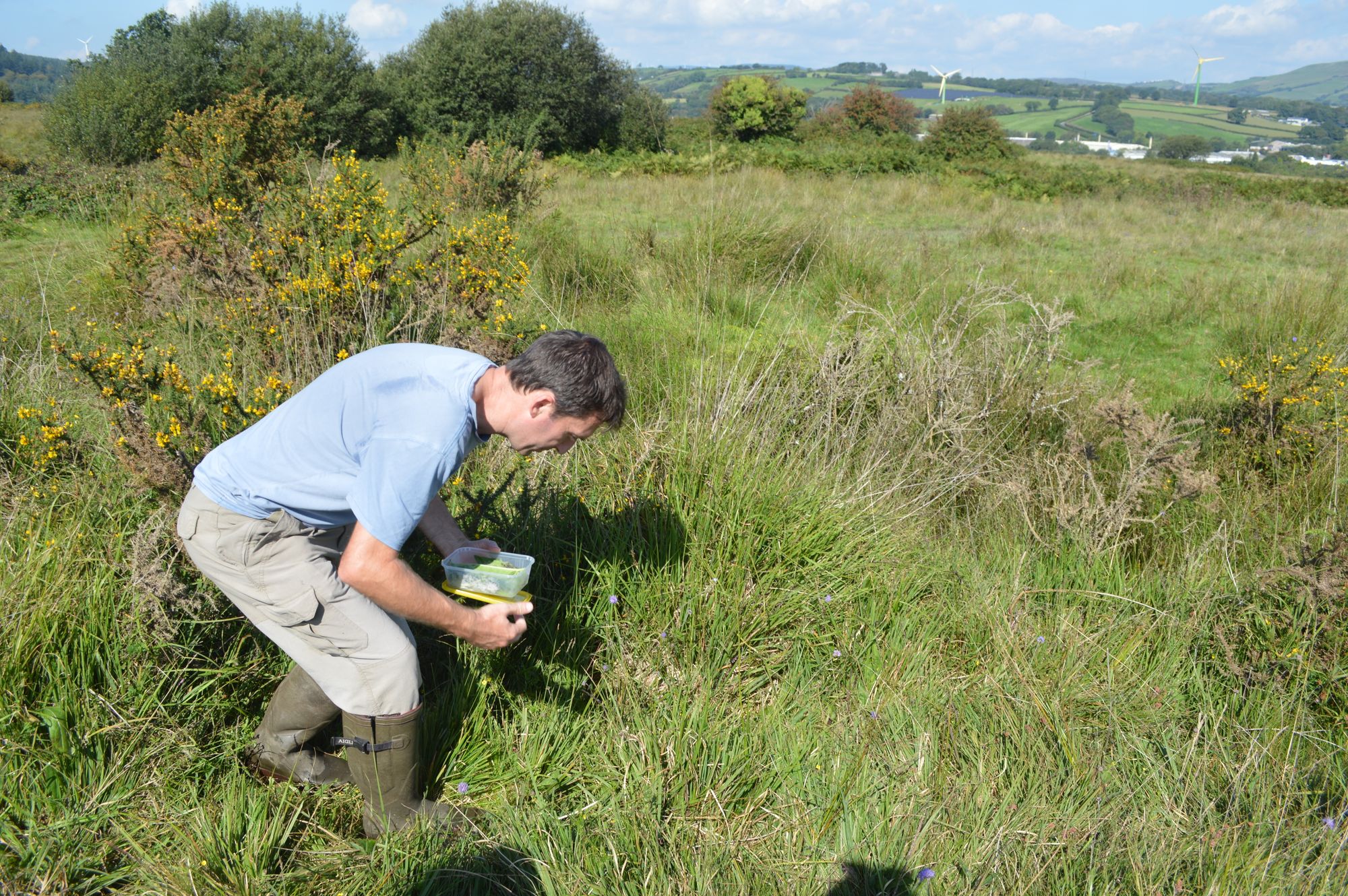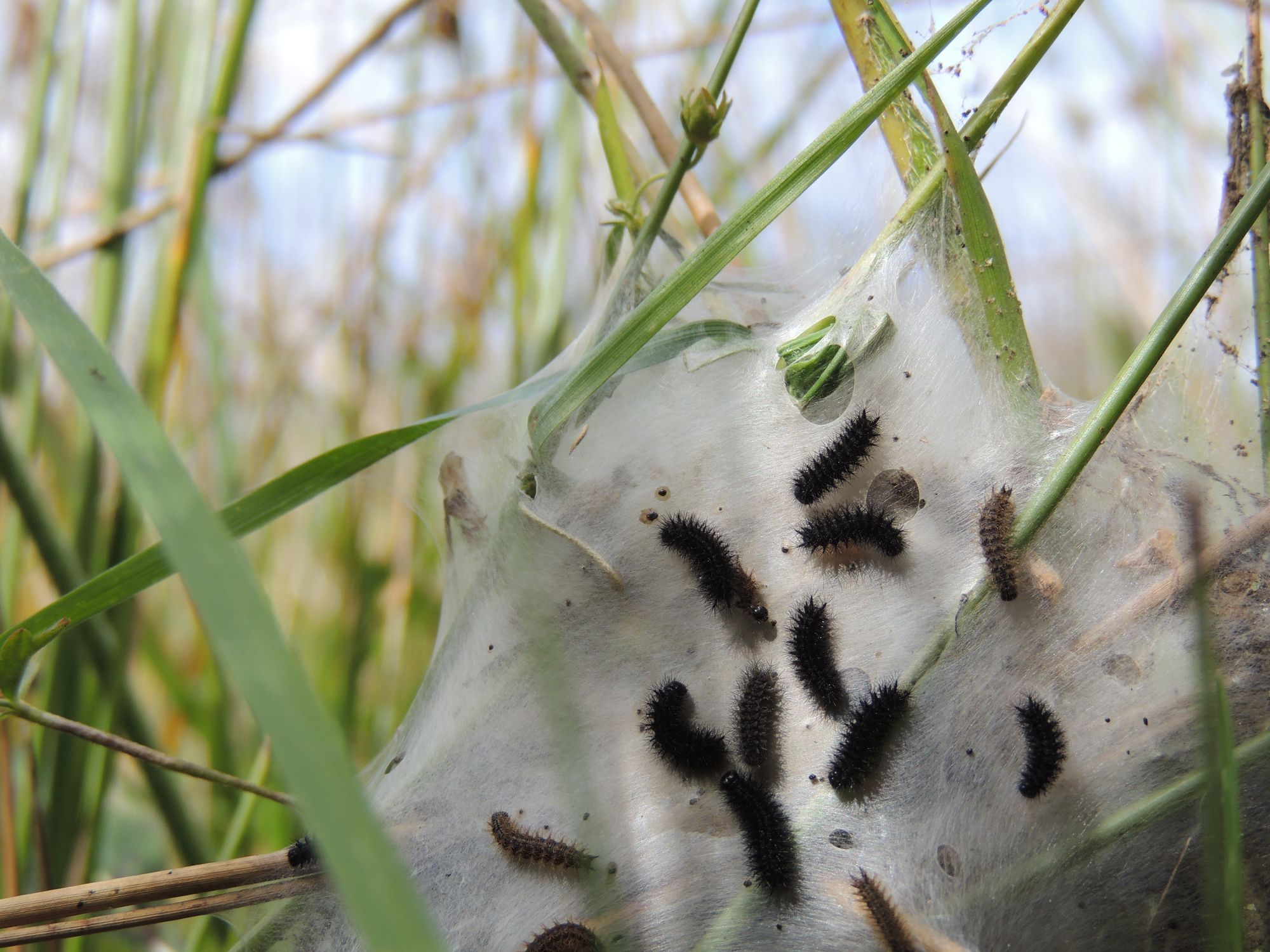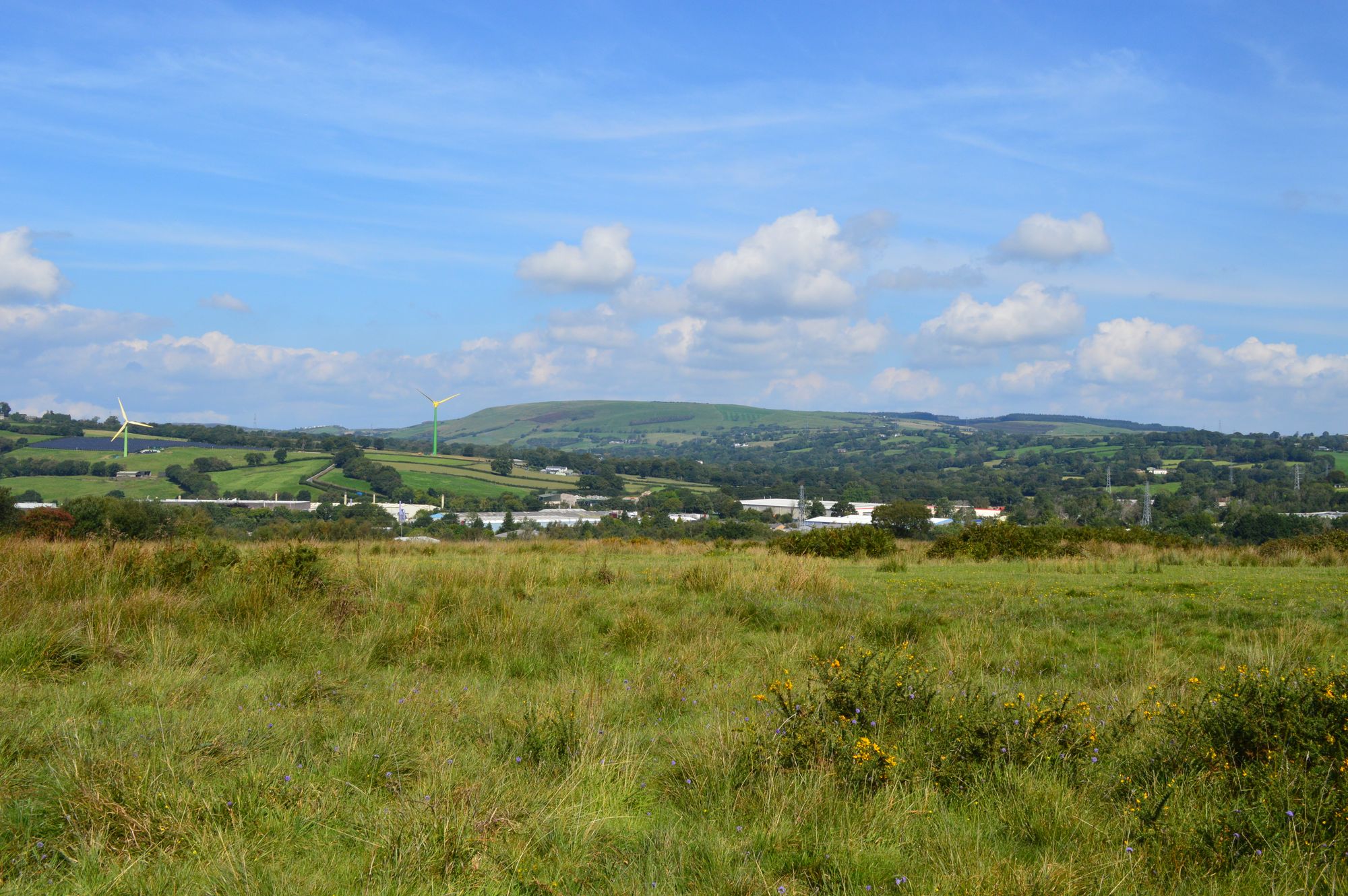
On Llantrisant Common, a butterfly took on the bureaucrats – and won
Conservationists despaired after an application to translocate caterpillars was denied, while another to kill them was approved. Yet, against the odds, the marsh fritillary is back.
In a car park on the edge of Llantrisant Common, Vaughn Matthews peels the lid off a plastic takeaway carton. Inside are leaves, webbing, and a brood of marsh fritillary caterpillars.
They look like miniscule black pipe-cleaners. But next year, if they survive, they’ll take to the air as butterflies, wings shining with shades of cream and amber. They will grace a place that, until 2021, had been without them for a quarter of a century.
The marsh fritillary is one of Europe’s most threatened butterfly species. South Wales has traditionally been a stronghold, but even here, populations are winking out. This is in large part because of the decline of the caterpillar’s key food source, devil’s-bit scabious.
This plant, and the butterfly, thrive best in what is known in Wales as rhôs pasture, with rhôs translating to moor or moorland. Its main components are purple moor-grass, rush, and damp ground. Thousands of years ago, such habitats were maintained in part by megaherbivores like aurochs. Nowadays, conservationists call on cattle and other livestock to do the job.
But when the cattle are removed or swapped for sheep, or the number of livestock grows too high, the rhôs is lost and so are the species that depend on it. And this is what has been happening across South Wales.
Overgrazing did for the butterflies on Llantrisant Common. When this became apparent, the Llantrisant Town Trust put in place a new grazing regime. The devil’s-bit scabious returned. But the butterfly did not – the nearest populations were simply too far away to reach the flowers under their own steam.
To have any chance of making a comeback, the marsh fritillary would need some help. And Vaughn, as part of the Initiative for Nature Conservation Cymru (INCC), is here to provide it.

I follow him onto the Common. Though bisected by a narrow road, these 113 hectares of pastureland feel fulsome with life. The ground is uneven and springy, the grass tussocks are fat, and the green is dotted with the deep purple of devil’s-bit scabious flowerheads.
Vaughn is seeking a nice tangled tussock for his caterpillars – the last of the latest batch to have been bred and raised by INCC. He is also on the lookout for the larval webs of those broods already placed out here on previous trips.
He strides ahead, his feet far more familiar with this ground than mine. He knows the signs of the marsh fritillary as well as any human could hope to. A few minutes later, he crouches by a tussock, fingers carefully parting stalks of grass.
“Often the first sign is just a brown staining of the leaf,” he says.
“Oh, yes, I think I see,” I reply. (I do not see.)
But with a little more judicious rummaging, the pale fibrous mass of a larval web is revealed. Broods of marsh fritillary caterpillars collectively spin these after hatching, to better protect themselves from predators and the elements.
I could have mistaken the one I am peering at for the home of a spider, but for the dirtiness: marsh fritillary larval webs fast accumulate frass and shed skins from past moults. There could be one hundred or so caterpillars in this one alone, although they’re too well-buried inside for me to discern their forms.

If the project seems small-scale, in one sense it is: the conservationists here are working not to return wolves to the hillsides but rather larvae to the undersides of leaves. And yet the journey to this point has been a long and trying one, shedding a light on the over-caution that still fetters ecological restoration in a world that seems to be changing far more quickly than many human minds.
The story began in 2016, when conservationist Rob Parry was working for the Wildlife Trust of South and West Wales. Fearing that South Wales could lose the marsh fritillary if no one helped it to reach suitable unoccupied habitat, Rob put in an application with Natural Resources Wales (NRW) to collect individuals from donor sites.
NRW said no. They contended that the focus should remain on habitat restoration and maintenance, and that it was too soon to take more drastic action. Rob despaired, especially when shortly after, NRW chose to grant the Wildlife Trust and Cardiff University a licence to collect and kill the same number of individuals to carry out genetic analysis. Fortunately for the caterpillars, that research never went ahead.
In 2019, as CEO of the freshly-formed INCC, Rob put in a new application for translocation. In 2020, it was finally granted. Rob didn’t probe why NRW had a change of heart; he “just took the win”, as he puts it.
By this time, the marsh fritillary’s hold in South Wales had become even more precarious. When INCC arrived at the donor sites the following spring, some populations had already shrunk too much to spare any of their remaining individuals. As a result, fewer could be collected than had originally been planned.
From the sites where they could be spared, the larvae were plucked in small quantities and brought to INCC’s base of operations, the National Botanic Gardens in Carmarthenshire. In rearing pens stuffed with scabious, they fed and moulted until they had almost reached the point of hibernation.

During this time, one extra complication emerged, literally: a wasp called Cotesia bignellii.
This species can only complete its life-cycle using the marsh fritillary. The female lays her eggs inside the living bodies of the caterpillars. After hatching, the larval wasps feed on the caterpillars from within, eventually killing them and breaking out of their corpses as adults.
Rob and his team were not completely horrified to find a few of the wasps perched atop the webbing of their precious wards within the rearing pens. They’d been aware it was a possibility. Besides, the wasp is likely even rarer than the butterfly.
“They do prevent numbers getting up too high. Obviously, if the butterflies outstripped the scabious, that would lead to their local extinction,” Vaughn tells me. “So the wasps are a potentially important controlling factor.”
Beyond that, C. bignellii provides yet another reminder that extinction is never self-contained; it unleashes multiple endings. The loss of the marsh fritillary from Llantrisant Common undoubtedly meant the loss of the wasp from there too.
For now, INCC is waiting to see if the wasp manages to recolonise the Common by itself. As for the butterflies, the initial data is encouraging. On 11 May 2022 – eight months after the initial translocation of larvae – the first of the adults took to the wing. In September 2022, the team found a total of 193 larval webs, partly using a thermal scope at night. It astonishes me that such small, non-mammalian organisms could generate enough heat for the scope to pick up – but together, they do.
While the count for 2023 is not yet complete, it looks set to improve yet again. INCC’s hope is that the population will not just become self-sustaining, but will also act as a productive hub from which individuals might strike out and recolonise more patches of the wider landscape, if the right habitat is available to greet them.
INCC is doing its best to ensure this happens, by planting out devil’s-bit scabious with the help of school children – who collect the seeds – and that of teenagers from the local college who have grown thousands of the plants so far. The habitat restoration work is being supported by a network of sympathetic landowners as well as NRW, who are now fully on board with the project.
The plan is to monitor the Common and nearby sites up to 2029 to try to see if the butterflies do indeed spread, although that is dependent on funding, which, for long-term monitoring projects, is not always easy to come by. Yet the knowledge that could be reaped from INCC’s project could prove a fire-starter for the rescue of other invertebrate species.
“It’s not just about the butterfly,” Vaugh reminds me.
INCC has set itself a challenge with the marsh fritillary. In many ways, it would have been easier for them to reintroduce a butterfly that was already locally extinct: “that way, at least it’s not your fault if something goes wrong,” as Rob wrote in a recent interim report.
Pernickety about food and, per Vaughn, a “terrible flyer” whose progress can be stymied by a large hedge, the species does not exactly help itself. But none of these characteristics should rob it of its right to exist.
A little further on from the wild larval web, Vaughan stops and crouches again. He opens the takeaway container, and gently transfers the leaves and the tiny beings tucked between them to the base of a tussock.
Sparks, waiting to catch.
Subscribe to our newsletter
Members receive our premium weekly digest of nature news from across Britain.
Comments
Sign in or become a Inkcap Journal member to join the conversation.
Just enter your email below to get a log in link.







